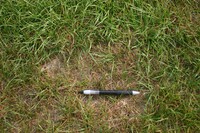By Pam Sherratt
Extended periods of cool, wet spring weather this year has triggered extensive leaf spot on lawns. This is a troublesome spring diseases on Kentucky bluegrass (especially common bluegrasses), fescues and other lawn grasses.  Some leaf spot can be found on most home lawns in the spring, but it normally does not cause significant damage to the lawn. This year due to the weather conditions leaf spot has occurred and now in progressing into the melting-out phase. Leaf spot is caused by several different fungi. The fungus overwinters in the thatch layer or in small lesions on leaf blades.
Some leaf spot can be found on most home lawns in the spring, but it normally does not cause significant damage to the lawn. This year due to the weather conditions leaf spot has occurred and now in progressing into the melting-out phase. Leaf spot is caused by several different fungi. The fungus overwinters in the thatch layer or in small lesions on leaf blades.
In spring, the fungus infects young succulent leaf tissue and causes the development of small elliptical dark colored spots. The spots eventually turn light tan but remain bordered by a dark brown outer edge. The leaf spot phase of the disease usually does not damage the plant significantly. However, during continuous cool, wet conditions, the fungus invades the leaf sheath and crown. The fungus also may invade the crown, rhizomes, and roots. As daytime temperatures increase, leaves on crown- infected plants begin to turn light green or yellow, similar to nitrogen deficient turf. Eventually these plants die and turn brown or straw colored. This is referred to as the melting-out phase of the disease.
Severe melting-out can result in irregular patches of dead turf. Damaged lawns often appear “thin” or uneven and tend to have weed problems. Excess thatch, heavy spring nitrogen fertilizing, excess shade, mowing too close and excessive herbicide applications can promote leaf spot and melting out.
Maintenance procedures to help manage leaf spot & melting out:
- Mow the turf high (2.5 – 3 inches) to provide leaves that produce food for the plant and maintain a healthier lawn.
- Avoid excessive nitrogen fertilization in spring which promotes lush growth. The use of fall and late fall fertilization is recommended. Once in the melting out phase maintain the lawn with a complete fertilizer at modest rate to encourage healthy turf and recovery. Often a starter fertilizer is recommended.
- Do not over water the turf if the lawn is irrigated.
- Manage thatch by frequent and heavy core cultivation (aeration) of the lawn. This will also promote a deeper healthier deeper root system.
- Plant resistant cultivars of Kentucky bluegrass. For information on these refer to the National Turfgrass Evaluation Program
- Fungicides can be applied but for best results need to be made early in the disease cycle or as a preventative treatment. This is done based on a history of the disease in the lawn. Unfortunately the most effective fungicides are no longer registered for use on residential lawns.

